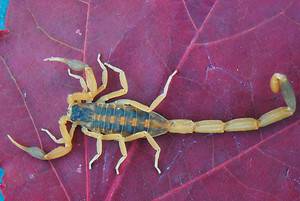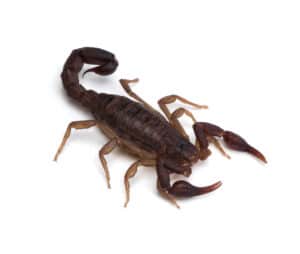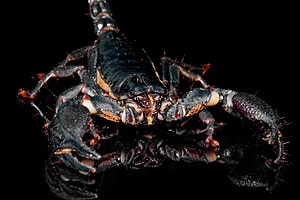Well known for their distinctive shape with pincers at the front and a curved tail with a stinger at the back, scorpions are easily identifiable. They are part of the arachnida class as – including their pincers – they have eight legs. With around 2,000 species, scorpions are well distributed across the world and are found on every continent except Antarctica, but although they are a very adaptable species and can live in most environments, their preferred habitat is still the desert. Most scorpions are quite small, with an average length of 6 cm (2 inches), but there are some species that prove to be the exception and far exceed the average.

Here are 10 of the largest scorpions by length:
#10: Deathstalker
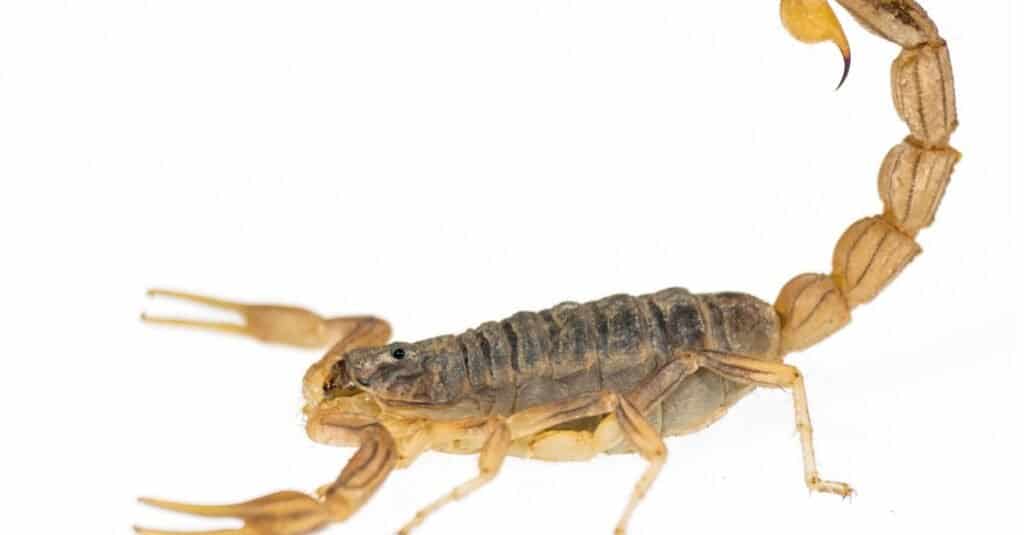
The deathstalker scorpion can reach 4 inches
©iStock.com/Javier Conejero
First on our list is the deathstalker scorpion, also sometimes known as the yellow scorpion, which can grow to a length of around 4 inches. The deathstalker is commonly found in the desert regions of North Africa, the Middle East, Central Asia and parts of India and is a light yellow color, hence its other name. With a lightning fast sting, the deathstalker is famed for being the most venomous scorpion in the world as it produces powerful neurotoxins. However, despite its chilling name, a sting from one would generally only be fatal to elderly people and children, with most healthy adults only experiencing a lot of pain and numbness in the affected area.
#9: Florida Bark Scorpion
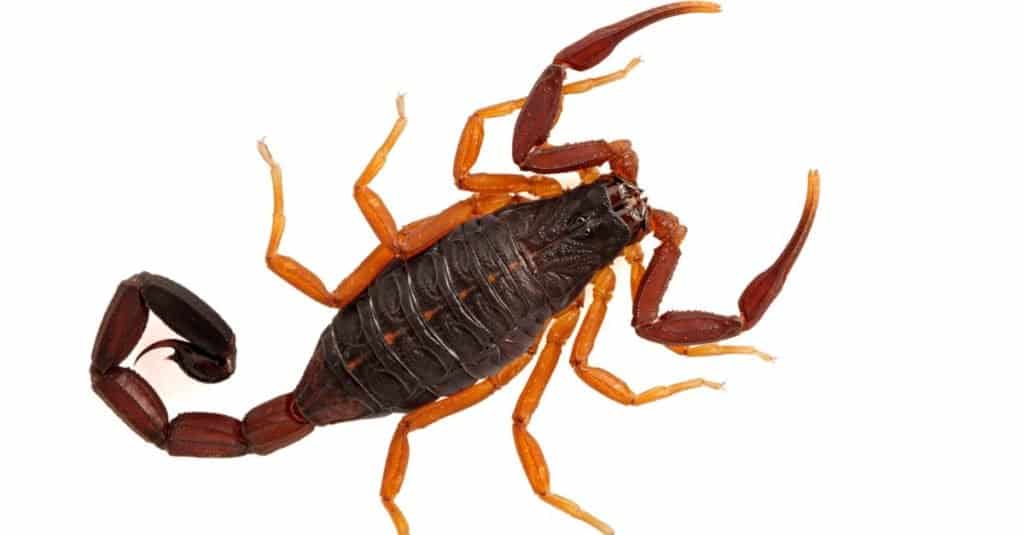
Beautiful sub-adult Florida bark scorpion, (brown bark scorpion), Centruroides gracilis, isolated.
©Ernie Cooper/Shutterstock.com
Slightly bigger than the deathstalker is the Florida bark scorpion which can grow to a maximum length of 4.7 inches. Also known as the brown or slender bark scorpion, it is usually found in parts of North America and Central America, including Florida, Mexico, Ecuador, and Jamaica and is also found in Cameroon and the Canary Islands. The Florida bark scorpion is a light brown color, with paler legs and yellow lines on its back. As the name suggests, they like to live in tree bark and also under rocks where they usually spend the day before coming out to hunt for small insects during the night. Although they are good hunters their main predators are tarantulas which commonly kill them, even when the scorpion has used its stinger to defend itself.
#8: Vietnam Forest Scorpion
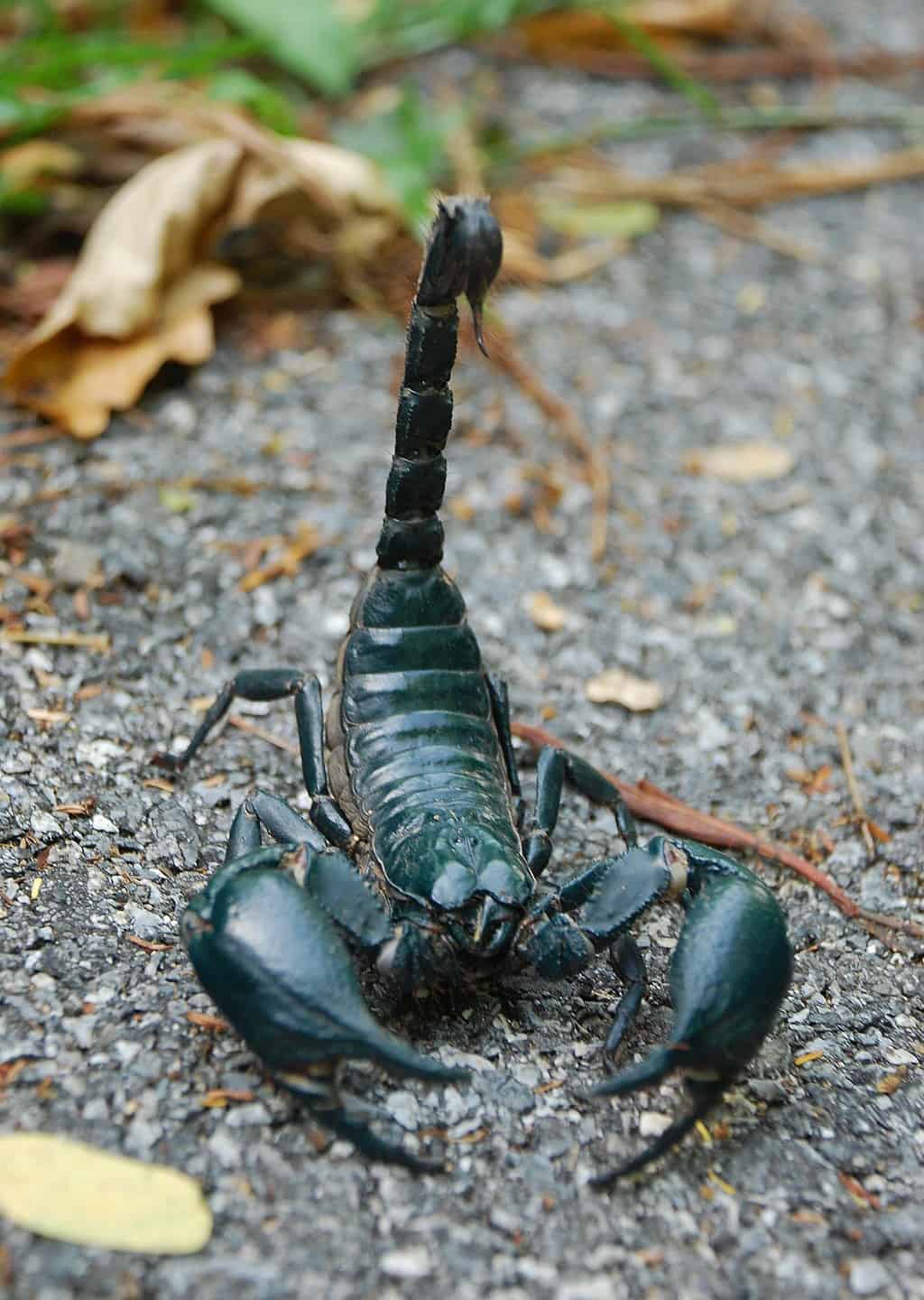
This scorpion,
Heterometrus laoticus, is also known as the Asian forest scorpion.
©Chris huh, CC BY-SA 3.0 <http://creativecommons.org/licenses/by-sa/3.0/>, via Wikimedia Commons – License
Vietnam forest scorpions are completely black in color and can grow to lengths of around 4.7 inches. Found in Vietnam and nearby Laos, they prefer a humid forest location so that they can hide on the forest floor underneath leaves and logs while waiting for prey. Although they are carnivores just like all other scorpions, Vietnam forest scorpions aren’t exactly fussy about what they eat as they are well known for eating other scorpions if one wanders across their path, often reacting extremely aggressively. Despite their violent tendencies, their venom is actually used to treat people who have infections such as pneumonia, and in Vietnam, they are both eaten and used as an ingredient in wine.
#7: Tanzanian Red-Clawed Scorpion
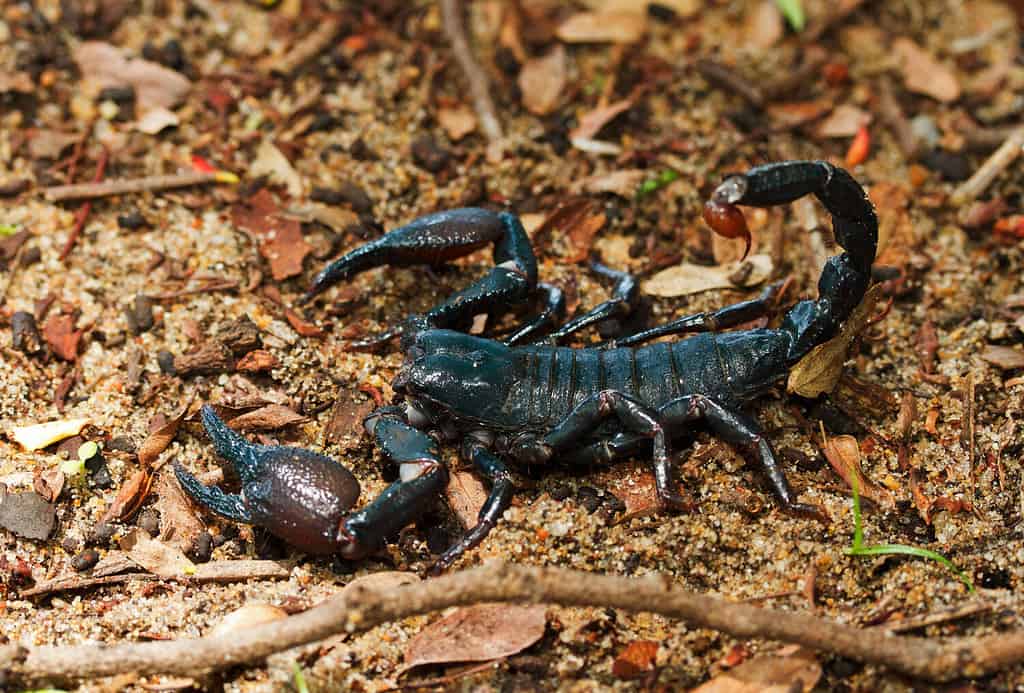
Compared to the other scorpions, this species produces a mild venom.
©Nick Greaves/Shutterstock.com
With a similar appearance to the Emperor scorpion, the Tanzanian red-clawed scorpion has a black body and pincers that have a slightly red tinge to them. Reaching a size of up to 5 inches, they are quite large scorpions that can be fairly aggressive when disturbed, although they only produce a mild venom compared to other species. The Tanzanian red-clawed scorpion prefers to live under rocks and logs and is found in the rainforests of Tanzania.
#6 : Transvaal Fat-Tailed Scorpion
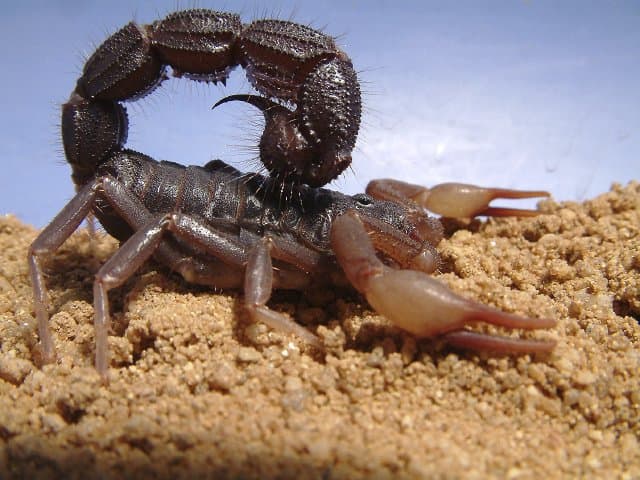
The Transvaal fat-tailed scorpion is also known as the Transvaalicus thick-tailed scorpion, giant deathstalker or the South African thick-tail scorpion.
©Alexander Tietz, CC BY-SA 2.0 DE <https://creativecommons.org/licenses/by-sa/2.0/de/deed.en>, via Wikimedia Commons – License
The Transvaal fat-tailed scorpion sometimes called the South African thick tail, is a distinctive species of scorpion that is easily recognizable due to the extremely thick tail that gives it its name. They are a dark brown color and can grow to around 5.5 inches. They prefer a desert habitat where they are commonly found underneath rocks and widespread across parts of Africa, including Zimbabwe, Botswana, Mozambique, Swaziland, and South Africa. The Transvaal fat-tailed scorpion is known as being one of the most venomous scorpions in Africa and eats a range of insects, spiders, reptiles, and amphibians. It is also particularly unique as it scrapes its stinger along its back to create a sound that acts as a warning sign.
#5: Malaysian Forest Scorpion

The Malaysian scorpion can grow to more than 6 inches
©iStock.com/Dwi Yulianto
Closely related to both the emperor and the giant forest scorpion, the Malaysian forest scorpion is completely black and can grow to around 6.3 inches. Found mainly in the tropical forests of Malaysia, Vietnam, and Thailand, these scorpions often make burrows in the ground or under logs. Although they regularly eat insects such as crickets and sometimes even mice, the Malaysian forest scorpion is capable of going a long time without food during periods when food is scarce. However, when they do come across food, they are able hunters and react aggressively with their stinger if they feel threatened.
#4: Giant Hairy Scorpion
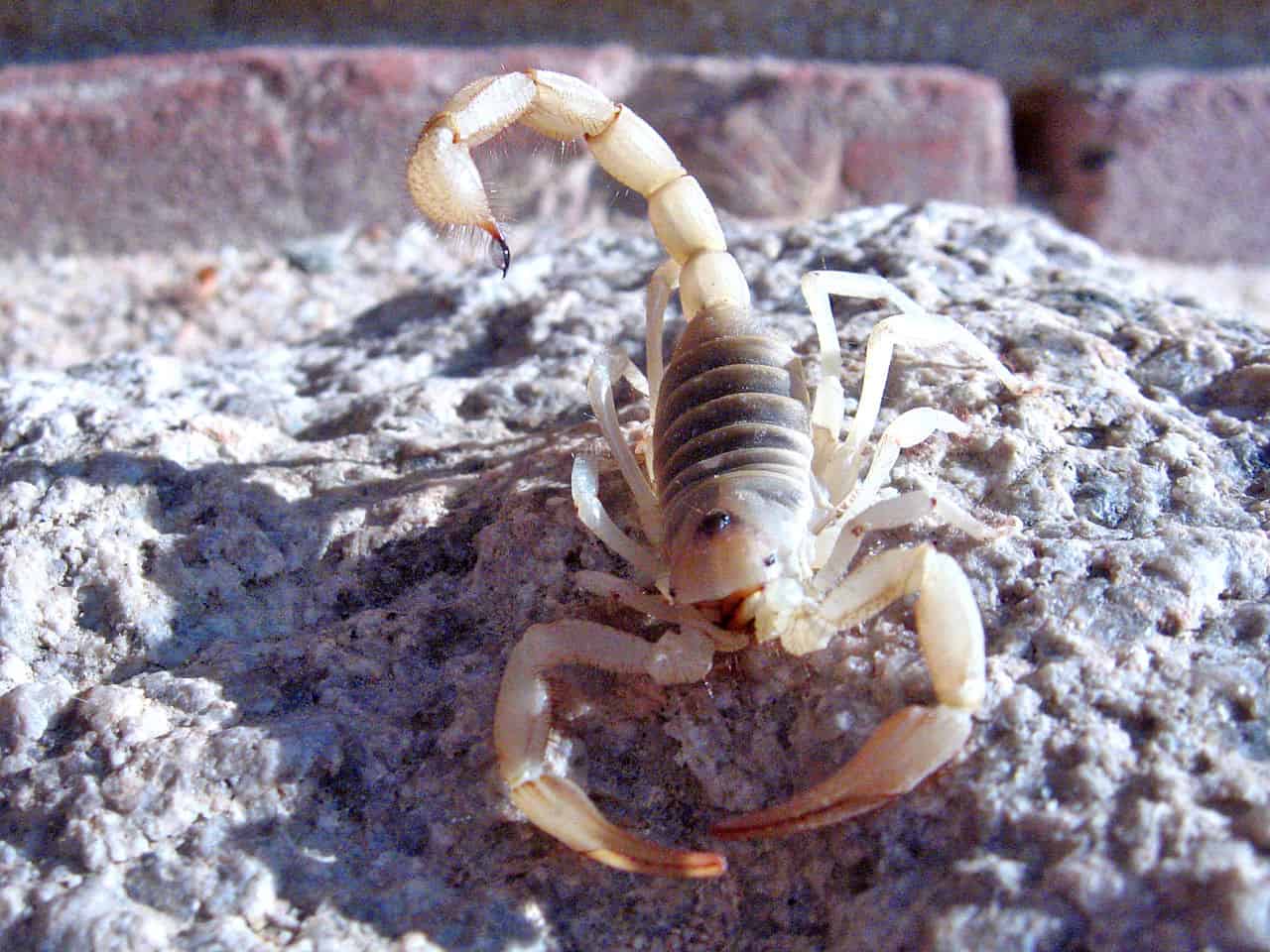
Also known as the Arizona hairy scorpion, this is the biggest scorpion found in North America.
©Robb Hannawacker, while working for Joshua Tree National Park / CC BY 2.0 – License
Also known as the giant desert hairy scorpion and the Arizona hairy scorpion, these are the biggest scorpions in North America, often reaching a length of 6.7 inches. The giant hairy scorpion is widespread across desert areas of Arizona, California, Utah, and Nevada. They have a distinctive color – usually having a green back and yellow legs – and get their name from the hairs that they have on their tails and legs. Due to their large size, they are extremely good hunters and often eat snakes and lizards, and even the giant desert centipedes that are found in Arizona.
#3: Emperor Scorpion
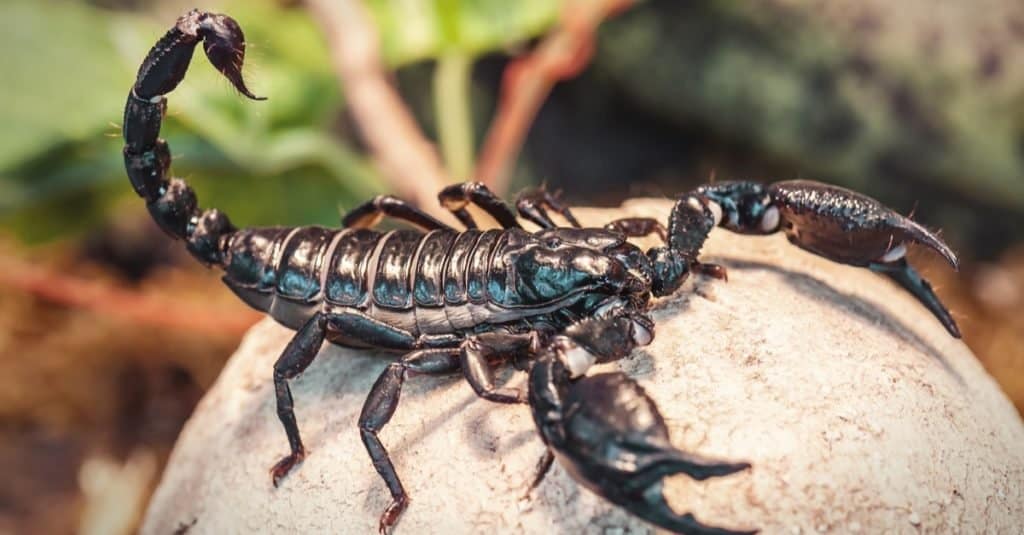
Black scorpion (Emperor Scorpion) sitting on a rock.
©Vova Shevchuk/Shutterstock.com
Fighting out the top spot on our list is the emperor scorpion which comes in at a length of 7.9 inches. Native to West Africa, the emperor scorpion prefers rainforests but is sometimes found in the savannahs as well. Although it is often confused with the Malaysian forest scorpion and the Tanzanian red-clawed scorpion due to its similar black appearance and red-tinged claws, the emperor is much larger than the other two species. However, despite their size, they are actually quite a docile species of scorpion that doesn’t act aggressively and has only mild venom, making them a popular exotic pet. When hunting, they often just use their large pincers to seize and crush their victims.
#2: Rock Scorpion

The flat rock scorpion can reach lengths of up to 8.25 inches
©iStock.com/Willem Van Zyl
Coming in at a length of 8.25 inches and taking the second spot is the rock scorpion which is found in South Africa and, as the name suggests, lives on rocks. It is also sometimes called the flat rock scorpion as it has a flat body that enables it to squeeze into small spaces between rocks. Rock scorpions are a dark brown color with lighter ridges on their backs. Their tail is much thinner than that of other scorpions which also makes them easy to recognize. Despite their size, their venom is relatively weak and would feel much the same as a bee sting.
#1: Giant Forest Scorpion
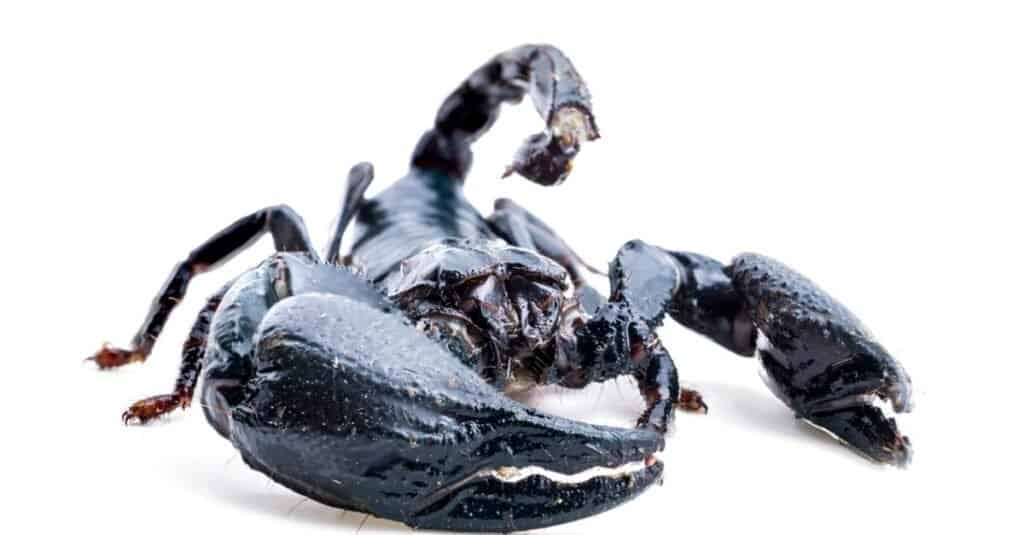
The giant forest scorpion is the largest scorpion species on record
©iStock.com/lamyai
The largest scorpion in the world is the giant forest scorpion with a whopping length of 9.1 inches and a weight of around 2 ounces. Widespread across the rainforests of Asia, particularly India and Sri Lanka, these giants are black or sometimes dark brown and eat a range of insects, lizards, reptiles, and other scorpions. Despite their impressive size, they have weak venom and are not particularly dangerous or aggressive and they only use their sting as a last resort when they are under threat. When hunting they usually catch their prey in their large pincers before tearing it apart with them. Giant forest scorpions are also extremely solitary animals and are only ever with another scorpion when they are mating.
Bonus: The Largest Scorpion to Ever Roam the Earth!
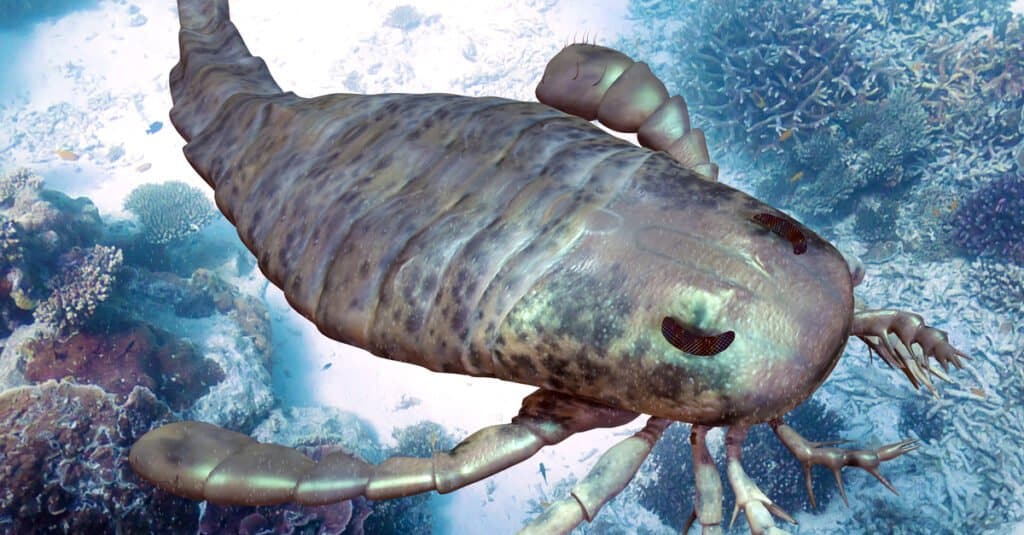
Sea scorpions reached more than 8 feet in length!
©iStock.com/Aunt_Spray
The largest scorpion to ever live on Earth was named the giant sea scorpion (Pterygotid eurypterid), and reached a length of more than 8 feet!
The sea scorpion was much different than today’s scorpion species! For one, it lived nearly 400 million years ago. Second, it hunted on sea floors while today’s scorpions live on land and mostly in desert environments. Thanks to their larger size, its believed sea scorpions weighed roughly one thousands times more than today’s land-dwelling scorpions! With this incredible size, they were able to hunt fish that weighed more than 100 pounds.
Thanks to their large size, sea scorpions were apex predators during the Devonian age. However, they were unable to survive a major extinction event and disappeared from the fossil record roughly 252 million years ago.
Summary Of The 10 Largest Scorpions In The World
| Rank | Scorpion | Size |
|---|---|---|
| 1 | Giant Forest Scorpion | 9.1 inches |
| 2 | Rock Scorpion | 8.25 inches |
| 3 | Emperor Scorpion | 7.9 inches |
| 4 | Giant Hairy Scorpion | 6.7 inches |
| 5 | Malaysian Forest Scorpion | 6.3 inches |
| 6 | Transvaal Fat-Tailed Scorpion | 5.5 inches |
| 7 | Tanzanian Red-Clawed Scorpion | Up to 5 inches |
| 8 | Vietnam Forest Scorpion | Around 4.7 inches |
| 9 | Florida Bark Scorpion | Up to 4.7 inches |
| 10 | Deathstalker | 4 inches |
What Keeps Scorpions Away?
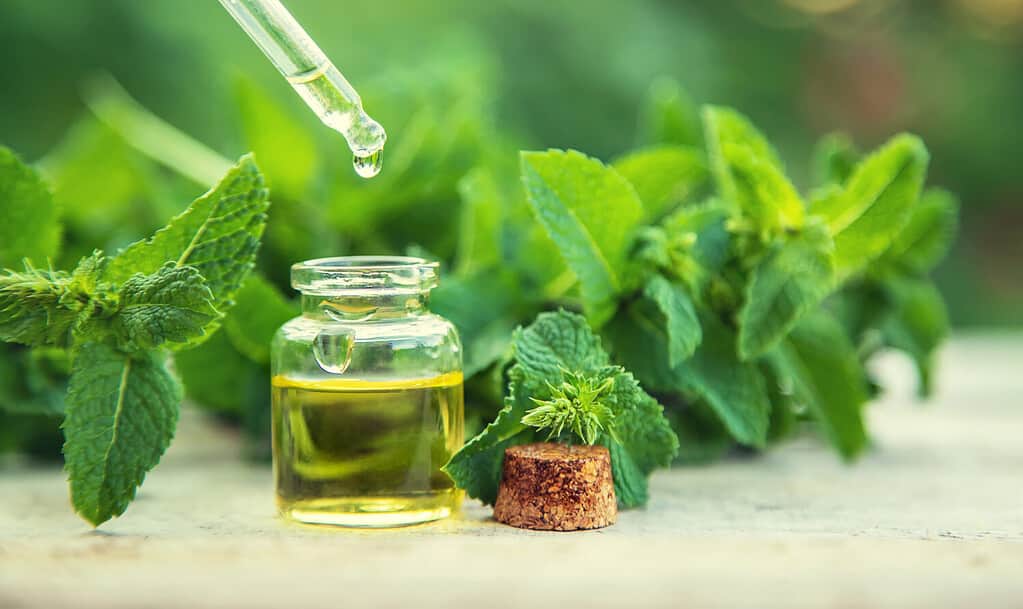
Use of certain essential oils like peppermint can help deter scorpions from entering your home.
©Tatevosian Yana/Shutterstock.com
One of a person’s worst nightmares is having a scorpion wind up in their home–especially the deadly kind! The best way to avoid getting stung by a scorpion is to try and prevent them from entering your house in the first place. As scorpions can get into your house through holes and cracks, you can check for possible entryways with a flashlight. If the light gets through from the inside to the outside, you should fill that hole or crevice with an appropriate product.
Keeping your yard free of debris helps cut down on areas scorpions would gravitate to. Scorpions are also drawn to moisture, so you should keep areas around your home dry where leaks or puddles may occur. Caulking doors and windows is also a good strategy to keep them out.
Scorpions hate certain scents, especially cinnamon, so you can sprinkle it around the baseboards of your home to help deter them. Essential oils like lavender, peppermint, cedar, and cinnamon can also be used near potential entry points in your home to keep these pests away.
The photo featured at the top of this post is © iStock.com/lamyai
Thank you for reading! Have some feedback for us? Contact the AZ Animals editorial team.



